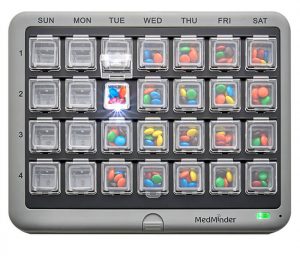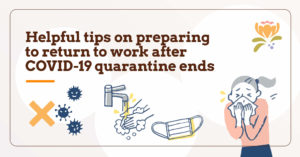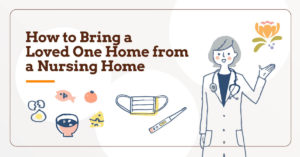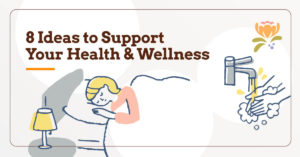Management of medicine – both for short-term use and for chronic care – can be overwhelming and is one of the most stressful tasks for relatives providing home care. Everyone understands that giving medicine correctly is paramount for the best, and safest, care.
In the United States, clinicians have access to more than 10,000 prescription medications. The number rises significantly when over-the-counter medications are included.
According to the American Association of Consultant Pharmacists, individuals aged 65-69 take an average of 15 prescriptions per year. This number increases to 18 by the time someone reaches 80.
With the high number of medications available and the widespread use, it is not surprising that there are nearly 700,000 emergency visits and 100,000 hospitalizations due to adverse drug events (ADEs) each year. (Source: Agency for Healthcare Research and Quality)
The good news is that ADEs are preventable. Assisted Living Services is leading the way in pairing care and technology to try and eliminate ADEs. Learning which questions to ask providers will help avoid common mistakes with prescriptions. Adding new technology to help track medicine administration will also benefit both the patient and the caregiver.
Read more to see how we can help with both.
Be an Informed Senior Advocate!
First and foremost a caregiver’s responsibility is to provide a safe environment for a patient. Ensuring that medications are dispensed properly is a priority. By asking questions in every step of the process, ADEs can be reduced.
Beginning at a doctor visit, make sure there is no miscommunication on what the drug is, what its purpose is and if there are any potential interactions with other medications being taken. Always have a doctor sign off on medications, including over-the-counter.
Pharmacists are busy and mistakes can happen. Being diligent when picking up a prescription can also help avoid mistakes. Some steps to take include:
- Checking the label and the pill before leaving.
- Can you read/understand the instructions?
- Does the pill look correct?
- Is it in a container that you can access – or one that can’t be accessed improperly?
Finally, at home, keep track of medication to be taken – both time of day it should be given and the proper amount, to avoid both overdose or missed doses. Additionally, the patient’s primary caregiver is best situated to be aware of a sudden change in health, which may signal an ADE.
The list below can be taken to a doctor’s appointment and the pharmacy to ensure all questions are answered and all caregivers know exactly what medications are being taken.
Questions to ask about new medications
- What is the name of the medication?
- What does this medication do?
- How should the medicine be taken?
- How long will the individual be taking this prescription?
- Is there a generic or less expensive version available?
- Is it able to be taken with other prescription or OTC medications?
- What should be done if a person misses a dose?
- Are there any lifestyle changes that may eliminate the need for this medication?
- If the medication is “as needed” what symptoms should be present before the medication is taken?
- Should any foods, drinks, or activities be avoided while taking the medication?
- Will any tests be needed to monitor how well this medication is working?
- What are the possible side effects of this medication?
- When will this medication start working?
At Home Medication Management
At-home medication management systems may make it easier for seniors to live at home. Tools today are vastly different than the simple pillbox – although these are often still a great solution for individuals with fewer medication directives. Many of these tools make use of technology, such as internet connectivity, to assist in safe medication dispensing.
The most common reason given for medication mismanagement is simply forgetfulness. One of the first devices Assisted Living Services and our Assisted Living Technologies partner was designed to address this issue with an automated medication dispenser.
Based upon our statistical analysis of automated medication dispensers implemented and in use throughout Connecticut, our clients’ medication compliance is above 90%. The national compliance average for patients 65 years old and older who take multiple medications is 50-60%.
A large reason for Assisted Living Services success rate with medication compliance is due to our personal interaction with our clients. By simply having a caregiver in the home we can drastically improve medication compliance. When our in-home services are paired with our CarePlus program, most incidences of ADEs can be eliminated. This unique program pairs personal interaction and technology to oversee the most important aspects of care. With this program, a technological device is provided at no additional cost.
Two of the products we recommend provide varying features at different price points.
 MedMinder is the most effective and affordable solution available to enhance medication adherence and allow for quick access to emergency services. Besides enabling personal interventions from caregivers, this pill dispenser offers patients a sense of comfort and companionship. Pricing ranges from $40 to $65 per month depending on the model needed.
MedMinder is the most effective and affordable solution available to enhance medication adherence and allow for quick access to emergency services. Besides enabling personal interventions from caregivers, this pill dispenser offers patients a sense of comfort and companionship. Pricing ranges from $40 to $65 per month depending on the model needed.- The MedReady Medication Dispenser w/ flashing light and monitoring automatically dispenses medication and vitamin supplements in accordance with prescribed treatment programs. If the dose is missed then our automated call center is alerted and you will receive a reminder call.
These are not the only options available for medication management. Other tools include smartphone apps that act as an alarm clock alerting an individual when it’s time for a dose, smart pill bottles that not only remind patients to take medication but are able to track when a medication was last taken and report missed or over-dosages back to caregivers or health providers, and internet-connected pill boxes that can be programmed for extended times.
At Assisted Living Services we understand that the many challenges a caregiver has in providing home care can be overwhelming. We are always happy to talk through the options available and find the best home care solutions for a specific situation, including medication management.
For more information on all of our technology resources, please visit Assisted Living Technologies. Learn more online about our CarePlus program or call us at 203-634-8668.






3 Responses
awesome post
Thanks for sharing a wonderful article.
We’re glad you found it helpful!